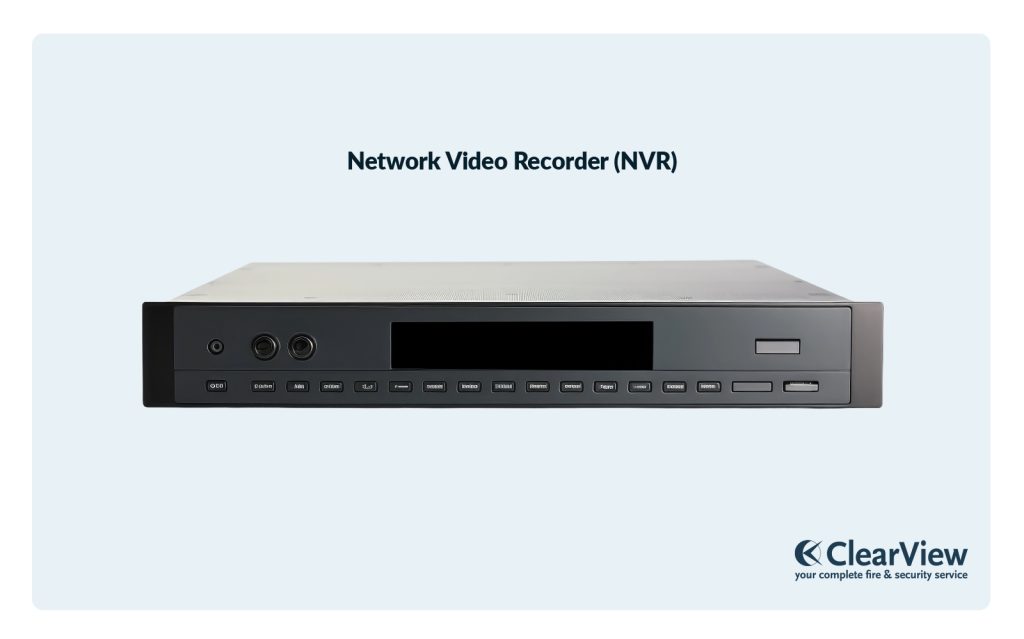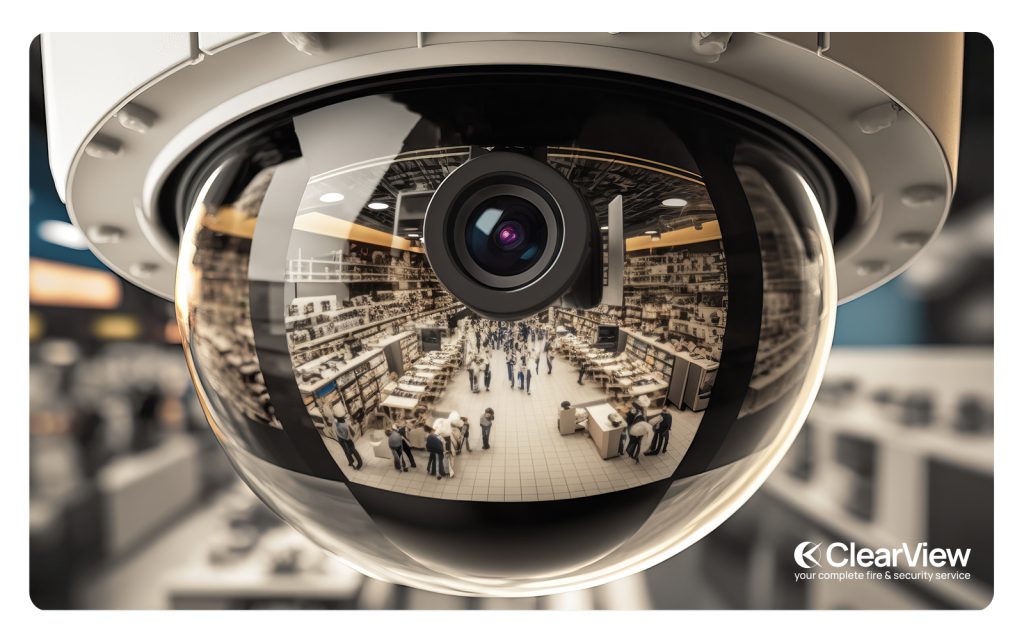In today’s world, the importance of security and surveillance can’t be overstated. Thanks to technological advancements, we’ve moved beyond traditional analogue setups into a new era where digital solutions reign supreme. These digital solutions, including Network Video Recorder (NVR) systems paired with IP cameras, have significantly elevated our security standards by offering clearer images, more efficient operations, and easier access to surveillance data. Whether you’re exploring surveillance technology for the first time or aiming to upgrade your current setup, this guide serves as a thorough introduction to NVR Camera Systems, delving into its structure, benefits, challenges, and much more.
For those consideranting installation, our CCTV installation services page provides detailed insights about our professional services to meet your specific needs.

What is an NVR system?
A Network Video Recorder (NVR) is a specialised device engineered to record video from IP (Internet Protocol) cameras. Unlike traditional setups that demand direct connections to each camera, an NVR leverages network connectivity, allowing flexibility in camera placement almost anywhere within the network reach.
Essentially, an NVR mirrors the functionality of a computer. It houses a processor, hard drive, and software, all tailored to handle the recording, storage, and remote access of the video footage from the connected IP cameras. The primary role of an NVR is to store video feeds on its hard drive, which can either be built-in or attached externally.
The standout feature of an NVR system is its synergy with IP cameras. Unlike other systems, IP cameras process the video data independently and then send this processed video over the network to the NVR. This way, the NVR system receives footage ready for viewing, and its primary focus shifts to storing and managing this footage for future viewing or retrieval.
In simple terms, an NVR system acts as a conduit between IP cameras and users. It securely stores the captured footage in a centralised location, making it readily accessible for viewing or playback whenever needed.
Anatomy of an NVR System
Understanding an NVR system requires a look at its foundational components. Each part plays a critical role in ensuring optimal functionality of the system. Here’s a more detailed breakdown:
- Processor: The processor acts as the central computational unit of the NVR, overseeing the software operations, managing data flow from connected IP cameras, and ensuring smooth storage of video recordings.
- Storage: Hard Drives: The hard drives are the primary storage medium within an NVR, retaining the video footage captured by the IP cameras. The capacity of the hard drives can vary based on the system’s specifications and intended use. Some advanced NVRs also support additional external storage solutions to accommodate extended recording periods. RAID (Rapid Array of Independent Disks) can be used to group hard drives together and allow fault tolerance in the event of disk failures.
- Software: The embedded software within the NVR oversees a multitude of tasks. It governs the interactions between the NVR and connected cameras, orchestrates storage protocols, and provides the interface for users to access, view, and manage the stored footage.
- Ports and Network Interface: These components serve as the connectivity hubs of the NVR. Ports enable the NVR to interface with other devices and peripherals, while the network interface ensures the NVR’s integration within a broader network infrastructure, facilitating functionalities like remote access and cloud storage.
- IP Cameras: Although technically external to the NVR itself, IP cameras are crucial to the system. They capture video footage and, thanks to their internal processing capabilities, transmit this video over a network in a format that’s ready for storage and viewing on the NVR.
These components construct a robust and reliable system that captures, stores and facilitates access to video footage with efficiency and precision.
Types of NVR Systems
While most people picture a physical box when they think of an NVR, the reality is that NVRs can be broken down into two main types:
- Standalone NVRs: These are traditional, physical units that come with their own operating system and dedicated hardware. These are typically easier to set up and are used in environments where a plug-and-play solution is needed.
- Software-based NVRs: Essentially, these turn a regular computer into an NVR. They are scalable, can be installed on existing hardware or virtual machines, and often offer more customisation options. They may require a more intricate setup, requiring further technical knowledge. NVRs for larger systems are often supplied as server hardware running a software based solution.
Benefits of Using an NVR System Over Other Surveillance Systems
The surveillance industry has witnessed the evolution of numerous recording systems, each with distinct advantages. However, when compared with other alternatives, NVR systems emerge as a preferable choice for a variety of reasons.
Scalability and Flexibility
NVR systems are inherently scalable. As they operate over a network, adding additional cameras to the system often simply requires ensuring the camera is on the same network. There is no need for direct cabling to the recorder, as is often the case with traditional DVR systems.
Higher Resolution Recording
Given that NVRs are designed for IP cameras, they inherently support higher-resolution video. IP cameras tend to offer superior resolution compared to their analogue counterparts, ensuring crisper and more detailed footage.
Centralised Management
With an NVR system, video footage from multiple IP cameras—regardless of their physical location—can be centralised and accessed from one unified platform. This centralisation streamlines the process of managing and reviewing footage.
Remote Accessibility
One of the standout features of NVR systems is the ease of remote access. Via the network, users can view live or recorded footage from virtually anywhere, given the appropriate software or application and necessary credentials.
To ensure continuous monitoring and security, explore our CCTV monitoring services, which provide around-the-clock surveillance options. Our team is equipped with the expertise and technology to offer you the best in surveillance and peace of mind.
Enhanced Security
NVRs, paired with IP cameras, offer advanced encryption methods. This ensures that video transmission over the network remains secure, mitigating risks of unauthorised access or data breaches.
Efficient Storage Solutions
NVRs provide a range of storage solutions, from built-in hard drives to cloud storage integrations. Their design allows for optimisation in storage utilisation, often employing techniques like motion-based recording to save space.
Integration with Modern Infrastructure
As a network-based system, NVRs can seamlessly integrate with modern IT infrastructure. This facilitates easier collaboration with other systems and software, potentially offering functionalities like advanced analytics.
The Limitations of NVR Systems
NVR systems have indeed elevated the realm of surveillance, but they aren’t without drawbacks.
Firstly, the financial aspect is worth noting. Top-tier NVR setups, complete with expansive storage and cutting-edge AI, can be expensive. The associated IP cameras also often come at a premium compared to their traditional counterparts.
The very strength of NVRs – their network-based operation – can sometimes be their Achilles heel. Any disruption in the network can jeopardise the flow and storage of crucial footage. This means an NVR’s efficacy often hinges on its network’s reliability.
In the cyber realm, the interconnectedness of NVRs also leaves them vulnerable. Their online nature can expose them to threats like hacking or malware, emphasising the need for robust cybersecurity measures.
Storage, while abundant, can quickly deplete, especially with high-resolution videos filling up the drives. This calls for proactive storage management. And, speaking of high resolution, these systems can be taxing on network bandwidth, leading to potential congestion issues.
Lastly, the software interface can sometimes be a mixed bag, ranging from feature-rich to slightly cumbersome. Integration with varied camera brands or older systems might also throw a spanner in the works.
While NVR systems offer a variety of benefits, potential adopters should be mindful of these inherent challenges to ensure they make well-informed decisions.
Comparison with Alternatives.
While the NVR system stands out in many respects, it’s essential to understand how it stacks up against other systems:
| Feature | NVR System | DVR System | Hybrid System |
|---|---|---|---|
| Scalability | High | Moderate | High |
| Resolution | High | Moderate | High |
| Cost | High | Low | Moderate |
| Integration with IP cams | Yes | No | Yes |
| Remote Access | Yes | Limited | Yes |

The Future of NVR
NVR systems have indeed elevated the realm of surveillance, but they aren’t without drawbacks.
Firstly, the financial aspect is worth noting. High-quality NVR setups, complete with expansive storage and cutting-edge AI, can be expensive. The associated IP cameras also often come at a premium compared to their traditional counterparts.
The very strength of NVRs – their network-based operation – can sometimes be their Achilles heel. Any disruption in the network can jeopardise the flow and storage of crucial footage. This means an NVR’s efficient often hinges on its network’s reliability.
In the cyber realm, the interconnectedness of NVRs also leaves them vulnerable. Their online nature can expose them to threats like hacking or malware, emphasising the need for robust cybersecurity measures.
Storage, while abundant, can quickly deplete, especially with high-resolution videos filling up the drives. This calls for proactive storage management. And, speaking of high resolution, these systems can be taxing on network bandwidth, leading to potential congestion issues.
Lastly, the software interface can sometimes be a mixed bag, ranging from feature-rich to slightly cumbersome. Integration with varied camera brands or older systems might also throw a spanner in the works.
While NVR systems offer a variety of benefits, potential adopters should be mindful of these inherent challenges to ensure they make well-informed decisions.
Frequently Asked Questions
This will depend on the type of NVR system you have installed. Commonly, NVR systems have a set number of channels, each channel supporting one camera. Common configurations are 4,8,16 and 32 channels, but it is possible to have additional channels, and more cameras. Speak to our team about your specific NVR requirements for a tailored solution.
Yes, it is possible to upgrade the storage of your NVR system, although the specific steps and the maximum capacity will vary from system to system. Most NVR models allow you to upgrade the existing storage up to a 6TB HDD, while others allow you to upgrade to 14TB. We strongly recommend you check the product documentation before considering replacing or upgrading your storage. Alternatively, you can always ask our team for guidance.
The decision between choosing an NVR or a Digital Video Recorder (DVR) largely depends on your specific requirements. Some key considerations when choosing between an NVR or DVR:
- Compatibility and wiring: NVR’s work with IP cameras and connect via a network switch or router, while DVR’s work with analog cameras connecting directly to cameras via coaxial cables.
- Scalability: NVR’s are easier to scale with the needs of your surveillance due to their network-based architecture.
- Data Storage: NVR’s support modern data storage solutions and redundancy options like cloud storage. In contrase, DVR provide a limited options.
Generally, NVR systems provide higher image quality, scalability, remote access and modern data storage. On the other hand, DVR systems might be more suitable if you’re looking for a more cost-effective solution, have a limited number of cameras or have existing coaxial cabling infrastructure.
Our team are always at hand to advise and reccomend the most appropriate system for your needs and budget.
The digital transformation of surveillance has opened doors to possibilities once deemed far-fetched. NVR Camera Systems stand testament to this evolution, offering robust, scalable, and high-resolution surveillance solutions that cater to a wide array of needs.
As with all technologies, it’s essential to weigh the benefits against the challenges, always aiming for an informed and strategic adoption. While we’ve explored the intricacies and applications of NVRs in this guide, the rapid pace of technological advancements suggests that even more refined and efficient systems might be on the horizon. As we look ahead, one thing remains certain: in the quest for enhanced security and surveillance, innovation knows no bounds.